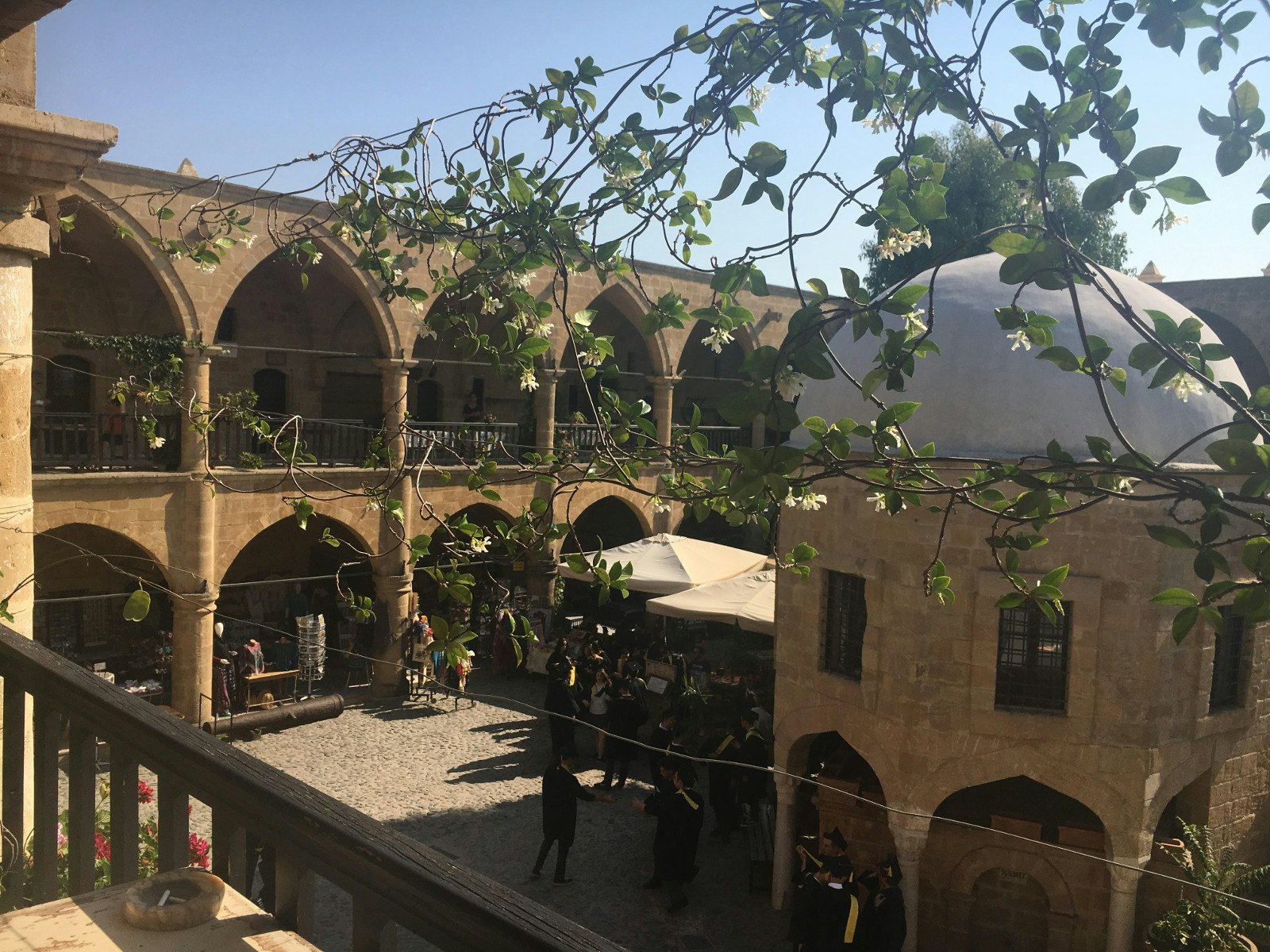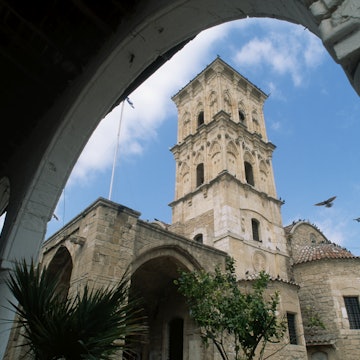

Fishing boats and traditional wooden ships moored in Kyrenia’s old harbour © Brana Vladisavljevic / Lonely Planet
‘Do you get many tourists in the north?’, I quiz the local guide Houssem Belloum as our minivan approaches the efficient UN Buffer Zone (aka Green Line) checkpoint. After the obligatory brief passport check, we continue our late-night drive from Larnaka airport in the south of the partitioned island to the old harbour town of Kyrenia (Girne) in the north. ‘Thank God, no’, he fires back, only half-joking. I know I have come to the right place.

Northern Cyprus is as off the beaten track as it gets in the Med. This sunny slice of land receives only a fraction of the visitors who descend on the southern coast’s resorts every summer. And yet – as I would quickly learn during my whistle-stop tour – it’s well worth making the trip across the Green Line.
The jasmine-scented old towns, like Famagusta (Gazimağusa) on the east coast, resemble walled open-air museums cramming fascinating history underneath the lanky minarets. The rugged coastline of the Karpas Peninsula, home to adorable wild donkeys and nesting loggerhead turtles, beckons with unsullied golden-sand beaches. And modest family tavernas, be it in slumbering villages or in the restless capital, dish up a meze-style feast of Middle Eastern flavours.

Where cultures collide
As you wander around northern Cyprus’ old towns, unexpected architectural twists whisper of civilisations that took over from one another throughout the centuries – and nowhere is this more apparent than in the Cypriot capital, bisected since 1964 into Nicosia (Lefkosia) and North Nicosia (Lefkoşa). The splendid Selimiye Mosque, once the Lusignans’ Gothic-style Cathedral of St Sofia, lords over the city with its twin minarets added by the Ottomans; marble columns taken from the Roman site of Ancient Salamis stand tall in its whitewashed aisles. And in the dilapidated Arabahmet quarter, some Ottoman-era townhouses still bear crosses on door lintels, a leftover from their previous Armenian owners.
Upon crossing the no-man’s land from north to south at the Ledra Street checkpoint, hectic bazaar stalls give way to fancy boutique windows, Turkish signs morph into Greek script, and street-side chatter switches to different sounds. I make my way to the Centre of Visual Arts and Research (CVAR), established in 2014 to promote the multicultural Cyprus and reconciliation of its communities. ‘It is the first and only intercommunal museum on the island’, points out Dr Rita Severis, CVAR’s executive director. Strolling around the chronological exhibition of paintings, photographs, maps and posters – mostly by foreign visitors to Cyprus – I ponder the 19th-century European travellers’ fascination with the Middle East.

CVAR isn’t the only one on a mission: an ongoing reconstruction of heritage sites is carried out across the island by a bicommunal committee. In northern Cyprus, this includes abandoned churches scattered around the countryside and cultural monuments such as the Lusignan-era Othello’s Tower (of Shakespeare fame) in Famagusta. Standing inside a tiny, dusty cave church in a remote corner of the Karpas Peninsula, I find the burned candles and icons resting on the rocks a humbling sight – a reminder that these forlorn places are still holy to Greek Cypriot believers.
Of course, the story of Cyprus stretches far beyond its modern-day complexities. I catch a glimpse of this glorious past at Nicosia’s Bank of Cyprus Cultural Foundation, whose impressive archaeological collection spans Mycenaean to medieval epochs, while a fantastic collection of coins conjures up images of trading ports and merchant ships. Those images turn haunting at the Shipwreck Museum inside the sturdy walls of Kyrenia castle, where spooky remains of the oldest shipwreck recovered from Cypriot waters – sunk by pirates around 300 BC and discovered in 1967 by a sponge diver – now rest, along with some of its ancient cargo and a curse tablet (intended to forever keep the ship at the bottom of the sea).

Food is made to share
Happily, the cultural mishmash that defines Cyprus is also responsible for the island’s cuisine – a riotous fusion of Greek, Turkish, and wider Middle Eastern influences – famed for its trademark hellim (haloumi) cheese. The time-honoured social aspect of food in the Cypriot community would turn each meal into a colourful feast over the course of my trip.
Countless small plates – from hummus, tzatziki or beetroot dips, olives, seasonal okra and pickled capers, to rice-stuffed dolmades (vine leaves) or pumpkin flowers, roasted eggplants, green beans, wild asparagus and creamy mushrooms – make an appearance, accompanied by carnivore delicacies such as şeftali (meatballs wrapped in fat). And traditional desserts like lokma (doughnut-type honey balls) are upstaged by more outlandish tooth-achers: carob pekmez (sweet syrup), chewy turunç macunu (bitter oranges in syrup) and crunchy ceviz macunu (fresh walnuts preserved in syrup).

It’s hard to go wrong when searching out places to dine across northern Cyprus. I learn it’s absolutely worth heading outside Kyrenia for a half-hour drive east to enjoy a full-on meze-style dinner extravaganza – with home-cooked dishes that just keep coming and excellent local wine – at family-owned Klepini restaurant (0542 853 1078) in the village of Arapköy. But wander off into old-town back alleys, and you’re bound to come across a tiny mom-and-pop joint where you might just enjoy the best meal on the island. One such place is Son Durak in North Nicosia, whose simple, traditional menu features whatever fresh ingredients are available, piled onto a huge plate and washed down with ayran (yoghurt-like drink); the restaurant closes as soon as the daily supplies run out.
The most memorable experience comes at the end of my trip, in Büyükkonuk. This village, 40km north of Famagusta in the foothills of the Five Finger Mountains, is home to a pilot eco-tourism project in the Karpas Peninsula – the brainchild of locals Lois and Ismail Cemal. Among their endeavours are craft and cooking classes, village festival and a slow-food market. Welcomed with a shot of zivania (fiery spirit made from grape skins), we settle in for a long evening of food and conversation at Kemeralti Aşevi restaurant (0533 863 5185). The next morning, I learn how to make syrupy Turkish coffee the traditional way, and the region’s own bulla (bread with haloumi, olives, greens and sesame seeds), baked in an outdoor wood-fired oven built of local stone. We munch on it in the breezy shade of an old mulberry tree at the Cemal household. ‘In Cyprus, bread is made to share’, says Louis.
Brana travelled to northern Cyprus with support from Intrepid Travel. Lonely Planet contributors do not accept freebies in exchange for positive coverage.













